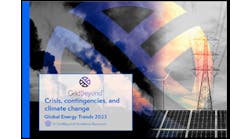If you don’t know the answer, join the club. Energy resiliency – maintaining a secure energy supply even when calamity strikes – is a key reason why many want microgrids in North America. But ssigning a dollar value to energy resiliency remains one of the most perplexing issues facing the microgrid industry today.
By MISHELLA/Shutterstock
Power outages cost the U.S. economy an average $18 to $33 billion annually, according to a 2013 White House report. But what are microgrid users willing to pay to avert this kind of loss? What’s it worth?
The issue was a key topic of discussion last week when microgrid industry insiders gathered in Arlington, Virginia at the annual Microgrid Markets Summit East.
Monetizing energy resiliency is especially important now because the microgrid industry is trying to hone microgrid financing packages. If resiliency isn’t priced as a microgrid benefit, money is left on the table.
Finance professionals need to figure out how this “extremely important element — resiliency – gets funded,” said John May, who is a managing director at Stern Brothers. Otherwise, microgrid projects may “suffer from a lower credit profile and thus higher cost of capital because no one is paying attention to how to resolve the resiliency finance issue.”
Philip Barton, director of Schneider Electric’s North American Microgrid Competency Center, called energy resiliency the Achilles Heel of microgrids.
“It is easy to use energy savings or lower cost energy production to pay for the microgrid…but it is sometimes hard to price in resiliency,” he said.
Barton said it’s important to think about what it costs to build other kinds of infrastructure, instead of a microgrid, to achieve energy resiliency. It takes more power plants, additional low-voltage equipment, and extra time in permitting. Microgrids bring everything into one unit, so you can achieve your aim more cost effectively than by doing separate projects.
Smoking 40 cigarettes a day
It’s easier to calculate the worth of energy resiliency in a country like Haiti where people pay high costs for unreliable energy. Allison Archambault, president of Earthspark International, noted that Haitians pay $100/kWh to charge their cell phones and the equivalent of $20/kWh to derive light from burning kerosene. “And it is also very bad for people’s health. Doing your homework over a kerosene lamp is the equivalent of smoking 40 cigarettes a day.”
The microgrid industry is contemplating various ways to reflect the value of energy resiliency in microgrid contracts. One idea is to add a payment premium to contracts. Or in some cases, the resiliency value can be recouped through state grants or Green Bank financing or even federal tax credits when microgrids use solar.
Steve Pullins, vice president of Hitachi Microgrids, said that he’s noticed a strong correlation between microgrid’s designed for economic reasons and those designed for resiliency.
“The types of things we did to enhance economics also enhanced resiliency. This was kind of eye opening for me. If you can get a microgrid to pencil, a byproduct of that is probably improved resiliency,” he said.
Learn about the latest approaches to microgrid financing by attending the Microgrid Knowledge conference in Manhattan on May 19.
Several speakers at the conference said they see the microgrid market eventually mirroring the solar industry’s dramatic growth. Both resources enjoy consumer support; people like the concept of local energy. But the solar industry didn’t really take off until company’s like SunEdison and SolarCity came up with replicable no money down packages for businesses and consumers. The same will be true for microgrids, May said.
“The value proposition for solar was always there. People liked solar on their rooftops. The question was could they get it for no money down, could they get it for really attractive financial terms,” May said.
He sees microgrids taking off once the industry settles on a “replicable financing methodology that allows for a whole groups or whole portfolio of these to be done.”
Indeed, scale is another sticking point for microgrid financing. Investors are more likely to finance bigger microgrids than smaller microgrids, given the return each offers compared to the effort and risk. Yet many of today’s community microgrids are relatively small.
“I’m going to either try to finance one-offs with an interesting story, or pool deals in groups,” May said. For example, he described a scenario where several community projects could be aggregated for bond financing. All would not be shovel ready at the same time; instead the aggregation would represent a construction pipeline.
Hitachi recently modeled the economics of 12 community microgrid proposals in New York that range in size from $3 million to $14 million each, according to Pullins. Together they represent a $70 million value, making them more likely to attract financing as a group than alone.
Not building a nuclear submarine
“There is plenty of money out there. We know where the money is. Once we figure out what the cash flows are, the math isn’t that complicated. We’re not building a nuclear submarine here,” May said. “I don’t see the story of microgrids as being so complex…or so novel, or so out there that funds already investing in solar, wind and clean tech will look at this as some sort of odd duck.”
But how quickly will the industry settle on a way forward? Hitachi’s Pullins sees it happening within just a couple of years. State incentive programs like the $40 million NY Prize and the Massachusetts Clean Energy Center grants will drive the interest and the requirement to figure out the business model, he said.
So, today the math around energy resiliency may be tricky; but the industry is confident it’s nearing an answer.
Meanwhile, customers are waiting. Konterra Real Estate, a development company that installed Maryland’s first private microgrid is now planning a 2,000-acre mini-city north of Washington, D.C. The developer would like to include a microgrid.
“We are environmentalist to the core…We would love to integrate resiliency, solar, microgrid, the works,” said Richard McCoy, executive vice president. “We would need a whole department to be able to focus on that. We don’t have the knowledge. The more you folks can pull it together…and have it make sense for us… we will be completely on board.”







